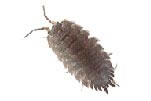
Common Pests – Woodlice
Description
Woodlice are a group of crustacean which inhabit rockeries and damp, sheltered corners in gardens. They evolved to live on land but still need damp conditions.
They are oval shaped, slate grey in colour, have 7 pairs of legs and are between 2.5 – 18 mm long. Some species roll up into a ball when disturbed.
Lifecycle and Habits
Woodlice, unlike many other crustaceans, live on land rather than in water, but they can only survive in moist conditions. You normally find woodlice outside where they can hide during the day in cool, dark and damp places – under stones and flower pots, in crevices, amongst dead and rotting vegetation etc. Woodlice come indoors mainly during the winter and early spring, usually searching for protection from the onset of cold weather. They do not come indoors to breed, but there may be a colony of woodlice near an entrance to the house. Once woodlice find their way indoors, particularly in warm dry rooms, they will die from water loss within a day or so. They may survive, however, under sink units in kitchens and bathrooms for some days, or even longer, particularly if they have access to food debris.
The female lays eggs in a pouch underneath her body. After about three weeks, the eggs hatch and young woodlice emerge. The young look like smaller versions of the adults and regularly shed their shells as they grow.
In the UK, wooklice breed during the summer months only, producing up to 200 young in a season. They have a lifespan of 1-4 years.
What Woodlice Eat
They live mainly on decaying vegetable matter, dead insects, fungi, and occasionally on the leaves and roots of young plants. Their main diet is decayed wood or other soft vegetable debris.
Problems Linked to Woodlice
Woodlice do not harm people or damage buildings but can still be a nuisance.
Preventing or dealing with an infestation
Sealing entry points (draught excluders around doors and windows, for example) can be tried, together with removing of other potential shelters near to the house – flower pots etc. Alternatively, by warming up parts of the house where woodlice have been found should help.
If an infestation is persistent, insecticidal powder or spray should be applied along the outside walls of the affected area. Also, small deposits of powder could be distributed on nearby ground and covered by stones or wood, to which the insects would be attracted.
When found indoors they should simply be removed, but a search should be made for any exterior nearby accumulation of rubbish or boxes and flower pots in which they may breed. These should be cleared up.
If insecticides are used you should follow the instructions carefully.
Professional help
It may be advisable to contact a reputable Pest Control company, either for advice, or to carry out a professional treatment. The British Pest Control Association has a list of its member companies on its website, for all areas.